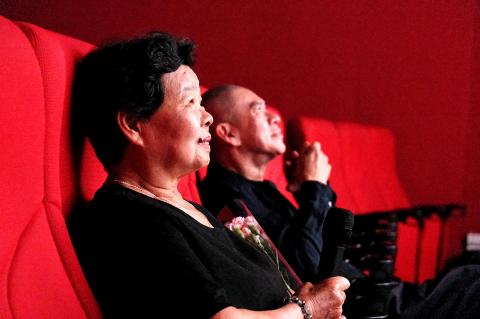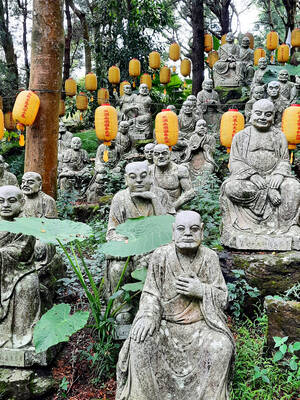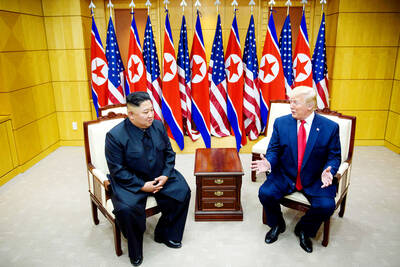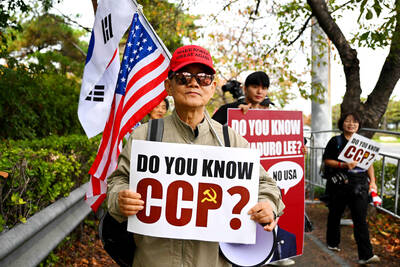Director Tsai Ming-liang (蔡明亮) has long been obsessed with the unwavering gaze of the camera.
The 61-year-old has been described as “a master of the very long take” by The Guardian. His name is synonymous with the genre of “slow cinema,” in which the camera lingers contemplatively on his subjects, who may or may not be saying or doing anything, as well as the things and scenes they leave behind long after they have departed the frame.
The effect is that time does not so much pass as it oozes and drips, like honey from beeswax.

Photo courtesy of atmovies.com
In Tsai’s latest, the 78-minute documentary Your Face (你的臉), the camera’s gaze comes to rest on 13 men and women literally cast from the streets of Taipei. Tsai opens a peephole into their lives, with varying degrees of insight and humor, and emerges with a collective portrait of the city and its people.
Slow cinema is not for everyone, especially audiences bred on a diet of standard movie time. The average shot length in films made today is 2.5 seconds; each of the 14 static shots in Your Face lasts several minutes. And if you’re looking for plot-driven action, there’s none of that. As the credits started rolling, one audience member a few seats down from me was heard whispering very audibly: “That’s it?”
But if you can muster it, the investment of time and attention to gaze at a stranger’s face can be as rewarding as meditation. With time, you might even get the sense that you are the one being gazed upon.

Photo: CNA
The Malaysian-born Tsai, who began making films in Taiwan in the late 1980s, remains one of Asia’s most influential living directors and a darling of the international arthouse and festival circuit, where he has been much feted over a 30-year career.
Not content to rest on his ample laurels and perform old tricks, Tsai has continued to strain against the boundaries of cinema — take for instance The Deserted (家在蘭若寺), his 2017 foray into virtual reality (VR) technology.
In a director’s statement, Tsai says that making the VR film, which required no traditional composition work, left him with the urge to shoot close-ups, which he decided to parlay into a film consisting entirely of close-up shots. Your Face is the resultant work.
Tsai spent two months searching for the right faces. While he has not been explicit about his selection criteria, the entire cast is middle-aged or older. On their faces, the etchings of time — gash-like wrinkles, watery eyes and gummy yellow smiles — prove more visually rewarding than unblemished youth, hinting as they do at lifetimes of joy and grief.
Each person has a unique reaction to being filmed unrelentingly in close-up. Some chortle at the novelty of it all; some fall asleep. Some speak unbidden; some are gently prompted by Tsai, who is a sympathetic and inquisitive interviewer. These are the most memorable, since Tsai draws out stories of hardship, serendipity and regret that make us feel like we know the people behind the faces.
To those familiar with Tsai’s oeuvre, one of the faces will seem like that of an old friend. Tsai’s longtime collaborator and leading man Lee Kang-sheng (李康生) appears here, as he has done in each of Tsai’s 11 feature films. Stripped of traditional direction, the actor looks straight into the camera and narrates childhood memories. Lee’s mother also features in a surprisingly sprightly sequence involving tongue exercises.
As Tsai writes in a Facebook post, he sent the famed Japanese composer Ryuichi Sakamoto a copy of the film after a chance meeting on a beach in Venice. A month later, Sakamoto responded with his music files.
“I wasn’t sure what I was hearing,” Tsai writes. “Sakamoto very graciously told me it’s up to you how you want to use it, you can also not use it.”
As a result, Your Face is the first of Tsai’s films to have a non-diegetic soundtrack, although Sakomoto’s arrangement of isolated notes, repetitive sounds and atmospheric roars — like that of a passing airplane, or a solitary whale song — is far from conventional accompaniment. Having no apparent correlation to what is on screen, it seems to describe instead the depths of thought and feeling that dip in and out of our placid exteriors, connecting us all.
When Tsai’s last feature film Stray Dogs (郊遊) was released here in 2014, the director announced that it would be his last narrative feature, that he was taking his films out of the cinema and into the gallery space to further interrogate the relationship between art and film.
With Your Face, he announced a reversal. On a crowdfunding Web site for the film’s theatrical release, Tsai writes that he now hopes to transform the cinema into a space for installation art.
These declarations of intent might seem like flip-flopping, but also show a veteran filmmaker’s continued thinking about the longevity and evolving role of the movie theater in a world where streaming into your bedroom has become the norm.
Like a site-specific piece, Your Face is being screened exclusively at Spot Huashan Cinema, where it is paired with Tsai’s 18-minute short film Light (光), an ode to historic Zhongshan Hall, where Your Face was filmed.
Your Face is now in competition at the Taipei Film Festival, where it has received nominations for best documentary, best director and best soundtrack. Winners will be announced at the festival’s closing ceremony this Saturday.

When Taiwan was battered by storms this summer, the only crumb of comfort I could take was knowing that some advice I’d drafted several weeks earlier had been correct. Regarding the Southern Cross-Island Highway (南橫公路), a spectacular high-elevation route connecting Taiwan’s southwest with the country’s southeast, I’d written: “The precarious existence of this road cannot be overstated; those hoping to drive or ride all the way across should have a backup plan.” As this article was going to press, the middle section of the highway, between Meishankou (梅山口) in Kaohsiung and Siangyang (向陽) in Taitung County, was still closed to outsiders

President William Lai (賴清德) has championed Taiwan as an “AI Island” — an artificial intelligence (AI) hub powering the global tech economy. But without major shifts in talent, funding and strategic direction, this vision risks becoming a static fortress: indispensable, yet immobile and vulnerable. It’s time to reframe Taiwan’s ambition. Time to move from a resource-rich AI island to an AI Armada. Why change metaphors? Because choosing the right metaphor shapes both understanding and strategy. The “AI Island” frames our national ambition as a static fortress that, while valuable, is still vulnerable and reactive. Shifting our metaphor to an “AI Armada”

US President Donald Trump may have hoped for an impromptu talk with his old friend Kim Jong-un during a recent trip to Asia, but analysts say the increasingly emboldened North Korean despot had few good reasons to join the photo-op. Trump sent repeated overtures to Kim during his barnstorming tour of Asia, saying he was “100 percent” open to a meeting and even bucking decades of US policy by conceding that North Korea was “sort of a nuclear power.” But Pyongyang kept mum on the invitation, instead firing off missiles and sending its foreign minister to Russia and Belarus, with whom it

The Chinese Communist Party (CCP) has a dystopian, radical and dangerous conception of itself. Few are aware of this very fundamental difference between how they view power and how the rest of the world does. Even those of us who have lived in China sometimes fall back into the trap of viewing it through the lens of the power relationships common throughout the rest of the world, instead of understanding the CCP as it conceives of itself. Broadly speaking, the concepts of the people, race, culture, civilization, nation, government and religion are separate, though often overlapping and intertwined. A government